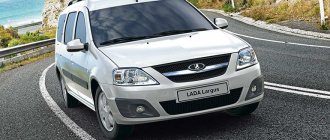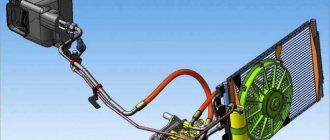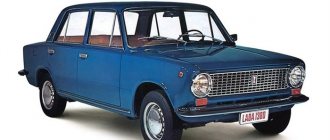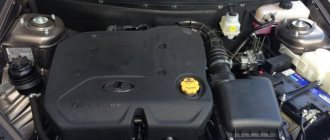Lada Largus is a Russian car built on the basis of the first generation Renault Logan MCV minivan. Initially, this model was called Dacia Logan, and was sold since 2006 in Romania. Production of the Russian modification began in 2011. Since then, the car has been produced virtually unchanged. However, unlike the original foreign car, Largus has several body versions. Thus, not only a minivan is available for sale, but also a commercial van, as well as an all-terrain version of the Largus Cross. In Russia, Lada Largus is considered the best-selling family car. The top-end version of the Lada Largus seats seven passengers and is also equipped with modern equipment and the ERA-GLONASS emergency warning system.
Lada Largus owner reviews
With engine 1.6 84 l. With.
- Maxim, Magnitogorsk. A worthy and irreplaceable option if you have a family. My wife and I bought Largus almost immediately after we got married. It happens that the car dealership had the copy we needed. Basic version, with 84-horsepower engine. The car requires 8-9 liters in the urban cycle.
- Julia, Tomsk. Not a bad car, VAZ did the right thing by remaking the car in its own way. Larugs is maximally adapted for Russian conditions, reliable and economical. In the city with a 1.6 engine and manual transmission it consumes 9 liters.
- Dmitry, Kaliningrad. I'm happy with the car; over five years of operation, Largus has proven what a real business executive he is. The car is indispensable in the country and in the city, the 1.6 engine fits into 9 liters.
- Konstantin, Murmansk. I took the station wagon version, with a seven-seater interior and a 1.6-liter engine. I like the car, it has already driven 78 thousand km, it is a reliable and comfortable car for family needs. Consumes on average 8-9 liters.
- Elena, Sverdlovsk. Largus is not perfect, but it copes with its functions without problems. It doesn’t let you down on a long journey, you can use it as a country taxi - there’s plenty of space in the trunk, and if anything you can increase it. Consumption is 8-9 liters with a 1.6 engine.
- Alexander, Krasnodar region. Larugs has a full-fledged seven-seater saloon, very roomy, my household can fit in there without much inconvenience. I liked the car, it is equipped with a 1.6 engine. In the city, consumption is 9-10 liters.
- Sergey, Novosibirsk. I'm happy with the car, it's an ideal car for every day. For family, work and long-distance travel. I have never regretted the purchase. A comfortable car, with an impenetrable suspension and good handling. Equipped with a 1.6-liter engine working with a manual transmission. 84 forces is enough for my needs, after all, this is not a sports car. Average consumption is 8-9 liters.
- Vasily, Pyatigorsk. I bought Largus in 2010, with a manual transmission and a 1.6-liter engine. This is my first generation Renault Logan, I had one like this. Nostalgia is off the charts, everything inside is recognizable and well made. Nothing has changed, and to some extent this is a plus. The car suits me, drives and brakes great. I'm even surprised, the station wagon is quite heavy and roomy. In the urban cycle, thanks to the 84-horsepower engine, you can fit in 8-9 liters, on the highway it turns out to be 7-8 liters.
- Ivan, Krasnodar region. The car is awesome, a worthy option for the city and the highway. In a family, the car is irreplaceable; absolutely everything fits. The rear seats can be folded down to create a spacious cargo compartment. The 1.6 engine works with mechanics and consumes no more than 8-9 liters in the city.
- Ekaterina, Tver region. The car is awesome, the best Russian minivan today. This is of course my opinion, and I do not impose it on anyone. I’ll tell you objectively, after all, Larugs has many more advantages than its competitors. First of all, of course, it’s the price; it decides a lot. With a 1.6-liter engine and manual transmission, I fit in 9 liters of 95 gasoline.
- Semyon, Belgorod. A modern car, and for little money. Why not take it? So I took it, I go and I don’t complain. Serious breakdowns - I don’t know of those. With a 1.6 engine and manual transmission, the consumption is 8-9 liters.
- Diana, St. Petersburg. A decent all-rounder, rides well and brakes effectively. All systems, including ABS, work smoothly and do not cause any complaints. With an 84 hp engine. With. you can keep within 8-9 liters per 100 km.
- Daniil, Penza. Great car, pleasing to the eye. I've had Largus for five years now, it's covered 138,000 km. The warranty has expired, you can service it yourself, I have my own garage. The engine is quite economical and reliable, and it is almost eternal. In the city it consumes a maximum of 10 liters.
With engine 1.6 87 l. With.
- Maxim, Ryazan. I bought a used Lada Largus, I work as a delivery driver of small and medium-sized cargo. In short, I am a courier with a personal car. I am glad that my employer fully pays my gasoline expenses. The car consumes an average of 9-10 liters per hundred, is equipped with a 1.6-liter engine and manual transmission.
- Oleg, Stavropol region. I took a Largus station wagon and was satisfied in all respects. The 1.6-liter engine can save gasoline and fits into 9-10 liters.
- Mikhail, Lipetsk. I’m already used to Largus; it’s been serving me faithfully for five years now. The odometer shows 176 thousand km. The largest expense is replacing the gearbox at the 150th thousand. A very reliable car, I drive it and have no complaints. Although it is budget, it has a lot of advantages. Spare parts are inexpensive. Average consumption is 9-10 liters.
- Nikolay, Petrozavodsk. Lada Largus 2016, with manual transmission and 87-horsepower engine. The car has proven itself in family and business affairs; you can’t find an alternative to Largus for that kind of money. There are simply no competitors in this price category. I have a 1.6-liter version, in the city it consumes 9 liters.
- Anatoly, Ekaterinburg. The car is beautiful, suitable for every day. A comfortable interior, a large trunk, simple finishing materials, the front panel is ergonomic, and you don’t need to get used to the controls. Everything is at hand. The manual transmission does not cause any complaints, all five stages turn on as they should. The 87-horsepower engine is just enough, for example, when driving uphill there is not enough traction. But it’s okay, you can get used to it, since Largus has a lot of other advantages. For example, it has a seven-seater interior, decent handling, and inexpensive spare parts. I only serve at official locations.
- Dmitry, Sverdlovsk. An excellent car, we can’t find an alternative for that kind of money. It turns out that Largus has no competitors at all, except perhaps the more expensive VW Touaran - I didn’t consider it at all when buying. Largus is enough, with a 1.6 engine and manual transmission it consumes a maximum of 10 liters.
- Ekaterina, Kazan. Lada Largus is an indispensable option for a family. A car for every need. The suspension is durable, you can load anything into the trunk. The 1.6 engine is reliable and economical, you can fit 9-10 liters.
- Dmitry, Nizhny Novgorod. I have a Lada Largus since 2012, it is a comfortable and economical car, it can be used to earn money. For example, I work for myself - I accept orders from people who move. You can fit a lot of things into the trunk; you can carry any luggage in three or four times. Ideal for those who find it too expensive to hire a large truck. Largus consumes 9 liters in the city.
- Maxim, Tver region. Larugs is reliable, does not creak or break. With a 1.6 engine and manual transmission it’s 10 liters per hundred. Impenetrable suspension, good gearbox performance.
- Denis, Chelyabinsk. I'm happy with the car, Largus does everything I ask of him. Consumption is at the level of 9-10 liters, I still have HBO - I put it in the trunk. There are no problems with spare parts, and branded service does not require large expenses.
- Alexander, Tambov. Lada Largus is a car for practical people who want more car for little money. Largus is very economical in the city, and its 1.6-liter engine has a decent reserve of traction both at low and medium speeds. Average gasoline consumption is 8-9 liters/100 km.
- Nina, Vorkuta. The car is worth the money, with a comfortable interior and optimal handling. In the city it doesn’t bother me, the traction reserve of the 1.6-liter is excellent, I like it. Gasoline consumption is 9-10 liters.
- Nina, Vorkuta. I'm happy with the car, I bought it for family needs. The car performs all assigned tasks. A spacious interior that can comfortably accommodate my three children plus a pet. It's not small, but it fits in the trunk. He is already used to it, sits quietly and does not disturb anyone during the trip. In the city, a fully loaded car consumes 10 liters of 95-octane gasoline; under the hood there is a 1.6-liter engine with an output of 87 horsepower, working with mechanics.
With engine 1.6 102 l. With.
- Daniil, Moscow region. I bought a Lada Largus for my own business. I run a small business and have several retail kiosks in my region. I need Largus to deliver groceries, and it does this task perfectly. 100 forces make themselves felt - especially when you urgently need goods. The car is fast for a heavy station wagon; in the urban cycle it consumes 10-11 liters of 95-grade gasoline.
- Mikhail, Sverdlovsk. I'm happy with the car, this car is ideal for our large family. I bought it with my wife and took the top version with a seven-seater interior. There is enough space. I liked the 1.6-liter engine, the consumption with it is at the level of 10 liters.
- Nikita, Kaliningrad. An excellent car, the best thing that ours and the French have created. Largus is maximally adapted to the Russian climate. In cold weather it starts with half a turn, is economical in the city, average consumption is 10-11 liters. The cabin is quite quiet and comfortable, with enough space for everyone.
- Tatiana, St. Petersburg. I took the minivan version, bought it in 2015. It took me two years to get used to the car and I drive it with pleasure. The 1.6-liter engine consumes 9-11 liters.
- Alexey, Sverdlovsk. A comfortable and reliable car, suitable for a family. I have the top version with a 102 hp engine. With. It’s enough, acceleration to the first hundred in 13 seconds is very good for a station wagon. Energy-intensive suspension, decent handling even on slippery roads. The trunk is enough for all needs; in a pinch, you can fold the back row to transport long items, such as a small refrigerator. Average gasoline consumption per 100 km is about 10 liters.
- Dmitry, Tomsk. I'm happy with the car, the car attracts me in all respects. A peppy 1.6-liter engine, with a decent reserve of power and traction, does not turn sour when driving uphill. The interior is just like the first Renault Logan, nothing has changed. Maybe it's for the better. In the city I fit in 10-11 liters.
- Nina, Smolensk. I'm happy with the car, I bought it in 2014. The car is quite powerful, with good driving and acceleration potential. Suitable for all types of roads, omnivorous suspension. The average consumption of a 1.6-liter engine is 10 liters.
- Nikolay, Bryansk. Lada Largus is the best car for a family, at least among its competitors, which in fact do not exist. The 1.6-liter engine is both powerful and able to save gasoline - you can keep it within 10 liters.
- Alexander, Novosibirsk. I decided not to be modest and took the Larus with the most powerful engine, and did not regret it. I would order it with an automatic transmission, but Larugs is not entitled to such a transmission - after all, the unification with the first Logan is obvious. The car is equipped with a 1.6-liter engine that consumes 95 gasoline. In the urban cycle, consumption is 10-11 liters. There are no complaints about controllability and reliability, and I would also like to note the inexpensive maintenance.
- Masha, Moscow. I bought Largus in 2016, it’s a normal car. In the morning I take the children to school and go to work with it, and pick up the children from work and back home. And without any breakdowns. Consumption 9-11 l.
- Olga, Orenburg. The car impresses with its dynamics and handling, even in some ways better than my old VAZ ten. All thanks to the 1.6-liter engine, which came in handy for the station wagon, consumption is 11 liters.
- Semyon, Vologda region. I like the car, Largus suited all the members of my family. The children and wife, together with the mother-in-law, are happy; everyone found something of their own in the car, dear. The car is reliable, I buy original parts. The 1.6 engine works with mechanics and consumes 10 liters.
- David, Nizhny Novgorod region. An excellent option for a family man or an avid summer resident. I use Largus’s advantages to the fullest and go fishing with it. The car has good cross-country ability, almost like a crossover. I thought about taking the Cross version, but it differs only in the lining on the body. Largus suits me, I am a practical person and do everything with my own hands. I also repair it myself. I like the car, the average consumption with a 1.6 engine is 10-11 liters.
Technical characteristics of VAZ-21129
Comparison table of Lada Vesta and XRAY engines:
| Engine model | VAZ 21129 | HR16DE/H4M | VAZ 21179 |
| Symbol | 1.6 l, 16 cl | 1.8 l, 16 cl | |
| Type | Petrol, 4-cylinder, in-line | ||
| Working volume, l (cm 3) | 1,6 (1596) | 1,6 (1596) | 1,8 (1774) |
| Cylinder diameter, mm | 82 | 78 | 82 |
| Piston stroke, mm | 75,6 | 83,6 | 84 |
| Compression ratio | 10,5 | 10,7 | 10,3 |
| Number of camshafts | 2 | ||
| Number of valves per cylinder | 4 | ||
| Timing drive type | Toothed belt | Chain | Toothed belt |
| When the timing belt breaks | Valve bend | – | Valve bend |
| Rated net power, kW/hp. (at crankshaft rotation speed, min -1) | 75/106 (5500) | 81/110 (5800) | 90/122 (6000) |
| Maximum net torque, Nm (at crankshaft speed, min -1) | 148/4200 | 150/4000 | 170/3750 |
| Minimum crankshaft rotation speed at idle, min -1 | 840 | 675-725 | 840 |
| Weight, kg | 92,5 | 105,4 | 109,7 |
| Ignition system | Electronic, contactless, microprocessor controlled | ||
| Cylinder operating order | 1-3-4-2 | ||
| Supply system | Multiport fuel injection | ||
| Fuel | Unleaded gasoline with octane number 95* | ||
| Availability of neutralizer | Eat | ||
| Toxicity standards | Euro 5 | ||
| Oil consumption depending on fuel consumed, % | 0,3 | 0,3 | |
| Oil volume in the lubrication system of an engine with a cast (light-alloy) sump (manual transmission), l | 4,1 | 4,7 | 4,1 |
| Engine oil quality class according to API* | SL, SM or SN | ||
| Engine oil viscosity grade according to SAE* | see motor oil | see motor oil | see motor oil |
| Resource, km | 200 000 | ||











